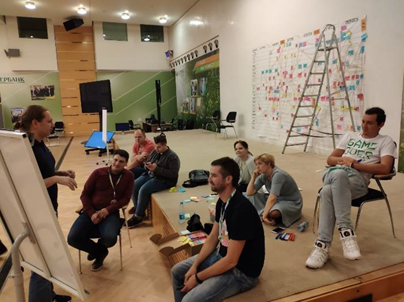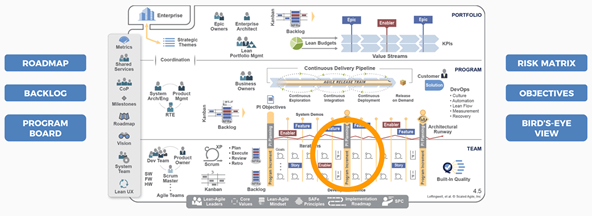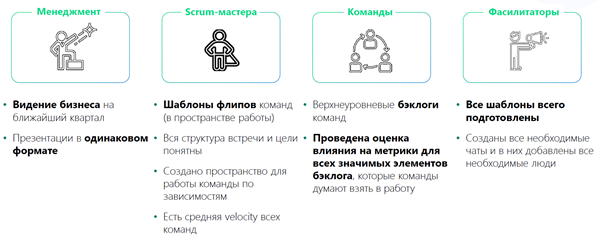This is a planning method from SAFe (Scaled Agile Framework), a flexible framework for large companies. Well, you know, this is when people stand at a wall covered with stickers, sculpt all sorts of strings from one sticker to another, but at the same time there is no maniac in the city.
Below is an example of a meeting place for one of the teams for PI in Sberbank (note the same wall in the background):

We all remember that in March 2020 everything changed: the pandemic and the self-isolation regime made their own adjustments. We “changed shoes on the fly” in a week, and what previously, as it seemed to us, was only possible offline, moved online.
How did it begin
In March 2020, most of the teams switched to a remote work format. The planning meetings had to do something. From a technical point of view, we had Zoom and Confluence, but organizationally, we had to do a little tweaking.
This is what SAFe looks like, and PI takes up a modest part of it:

Here's what the different actors need to do to make the planning successful:

In planning, executives needed to be told about the goal of the product for the quarter so that the mini-teams that were in self-isolation had a holistic understanding of the picture.
Scrum masters were assigned to prepare all flip templates (flipcharts). Online, they morphed into Confluence signs in a dedicated collaboration space.
The teams were given the task to communicate in advance with the maximum number of stakeholders so that they already roughly understand what will be expected of them. This greatly reduced the time of the meeting itself, everyone was already ready. Plus, the teams had to assess all their tasks at least at the highest level.
A team of facilitators made sure that all templates in Confluence were ready and everything was logistically ready.
We focused on the main tasks and distributed them as much as possible. Must have tasks are tasks, for example, to change legislation, which changed quite often during the pandemic, and you cannot be ready for this, but they definitely need to be done. As a bank, we do not have the slightest opportunity not to do this in principle.
The second type of unusual tasks is “orphans”. Imagine that you are a product owner, you have a team, you understand how to develop your product, but you see something from the outside that also needs to be done. And this is important. But you can't, your backlog is full and your tasks are more important. Then you take this task and place it in a special space where all the tasks that need to be done live. And, of course, to clarify and look at the effects, why, in principle, we need them.
The story itself has hardly changed: if before there were physical flipcharts, now they have become virtual.
The first space is about the goals that the team will achieve during the quarter. The team shows what metric it is processing, shows its current state, future state, when it can be measured, financial effect and what tasks will cover this metric, changes are achieved.
The general flip of the metric is so that anyone passing by it can immediately understand what state the product is in at the moment, in what state it will be in a quarter.

The next one is a dependency flip: our huge dependency board has migrated into a small table that simply indicates what kind of direct relationship a team has with another team.
Then there are the risks. If a team sees that it may have problems in the implementation of a task, then it designates it, and then we already decided who works with it and how.

And then - the distribution by sprints. We looked at the optimism, pessimism and realism of the teams and led them to something unified, equal. Those who were not loaded - were loaded, and who were overloaded - they helped a little to free their backlog.
And one more flip, on which the participants indicated their contacts, by which they could always reach the team and discuss the backlog for the quarter.
Process
We are booking two days for this job so that everyone has time for everything. The beginning on the first day - at 10 am, telling the business, where we are going, what the main key goals the business expects from us, what the main changes in architecture can be.
Next comes the work of the teams:
- The first part, when the teams are just discussing the goals and inner workings, descriptions of the sprints, they talk with the subcontractors, with the stakeholders.
- Sync teams when you can find a team in Zoom, talk to them. Under this - half a day, it is important that they are all in place and waiting for you.
On the second day, teams talk about their goals, their metrics, where they go, and are already verified with all stakeholders. Then there is always a discussion of risks. Next is the vote for confidence, how much the team generally believes in what it has planned. Let's say five is for sure, straight for sure. At the end - collecting feedback and a retrospective.
It has become more convenient in electronic form: a clear structure has appeared, a better preservation of artifacts has been added. Each challenge is posed in Confluence.
On average, 70-80% of what was planned is actually done. This is a very qualitative indicator.
Investment in the future
PIPs are needed because planning is an investment in the future. After planning, when all the teams worked closely with backlogs, with dependencies for two days, discussed everything "on the shore", the subsequent events, scrum and planning in the team take much less time.
So, in a nutshell about PI Planning. If you want more details, you can watch the presentation of colleagues here .